![]() October
October
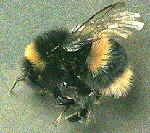 This
month's issue completes our first year of Walks
This
month's issue completes our first year of Walks
This month, we look at just one subject, a bee, to illustrate that a single insect can provide a wealth of study on both the macroscopic and microscopic scale.
In addition, to complete a full year of Walks, we look at ways of photographing nature for the 'Web'. Why not capture nature in close-up in your part of the world and submit a few favourite images to us. We would be delighted to compile a selection of these international snapshots for the Micscape magazine!
Next month, Maurice Smith will continue the walks, while the author will be starting a new challenge. A series on the world in close-up around the home .... looking at all those items we take for granted around the home and office but which can be fascinating in close-up.
Please read the important notes on collecting.
Wings
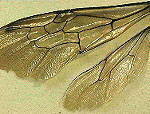
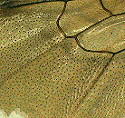 The bee has two pairs of wings and one pair (of the
fore and hind wings) is shown on the left. Bees are part of the
immense order of insects called Hymenoptera which also includes
ants and wasps amongst others. In this order the wings are joined
by a row of minute hooks on the leading edge of the hind wing.
Note that the wing venation is quite simple and produces a
network of large and often square 'cells' which is typical of
this order. If you compare the venation with a dragonfly for
example, the latter have much more complex venation and smaller
'cells'. Insect wings have many fascinating features and are
worth examining under the compound microscope to study the hair
structure, venation and the hooks mentioned above. The image
right shows a closer view of the wing.
The bee has two pairs of wings and one pair (of the
fore and hind wings) is shown on the left. Bees are part of the
immense order of insects called Hymenoptera which also includes
ants and wasps amongst others. In this order the wings are joined
by a row of minute hooks on the leading edge of the hind wing.
Note that the wing venation is quite simple and produces a
network of large and often square 'cells' which is typical of
this order. If you compare the venation with a dragonfly for
example, the latter have much more complex venation and smaller
'cells'. Insect wings have many fascinating features and are
worth examining under the compound microscope to study the hair
structure, venation and the hooks mentioned above. The image
right shows a closer view of the wing.
Head
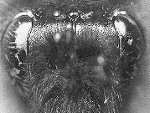 Insect heads are particularly
fascinating to study in close-up because the the eyes, antennae
and mouthparts can be examined. Under a stereo microscope you may
need to use a good strong external light source and to vary the
lighting angle to see the details on the dark head. The image
right shows the bumblebee's compound and simple eyes. The simple
eyes or ocelli are the three black beads in a row at the top of
the head. The ocelli are simple structures and can only detect
light, darkness and movement. The compound eye is made up of a
number of hexagonal facets which resembles a honeycomb. The
number of facets effects the visual acuity and varies amongst
different insect species, the housefly for example has 4000
facets whereas the dragonfly has up to 28000. The honeybee's eye
is estimated to have one per cent of the visual acuity of a human
eye.
Insect heads are particularly
fascinating to study in close-up because the the eyes, antennae
and mouthparts can be examined. Under a stereo microscope you may
need to use a good strong external light source and to vary the
lighting angle to see the details on the dark head. The image
right shows the bumblebee's compound and simple eyes. The simple
eyes or ocelli are the three black beads in a row at the top of
the head. The ocelli are simple structures and can only detect
light, darkness and movement. The compound eye is made up of a
number of hexagonal facets which resembles a honeycomb. The
number of facets effects the visual acuity and varies amongst
different insect species, the housefly for example has 4000
facets whereas the dragonfly has up to 28000. The honeybee's eye
is estimated to have one per cent of the visual acuity of a human
eye.
Body hairs

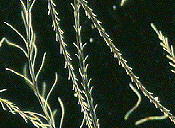 Bumblebees are hairier than the honeybee and possess
dense bands of coloured hairs (see image left). The hairs are
long enough to easily snip off with a small pair of scissors, and
they can be mounted dry under a coverslip on a microscope slide
to examine at higher magnification using a compound microscope. A
selection of hairs are shown right using dark-ground illumination
and a 9x objective (screen magnification 120X) which highlights
the structure of the semi-transparent hairs (diameter 15-25
microns) quite clearly. The author, who had never examined these
hairs before, was intrigued to find that each hair had an
intricate structure.
Bumblebees are hairier than the honeybee and possess
dense bands of coloured hairs (see image left). The hairs are
long enough to easily snip off with a small pair of scissors, and
they can be mounted dry under a coverslip on a microscope slide
to examine at higher magnification using a compound microscope. A
selection of hairs are shown right using dark-ground illumination
and a 9x objective (screen magnification 120X) which highlights
the structure of the semi-transparent hairs (diameter 15-25
microns) quite clearly. The author, who had never examined these
hairs before, was intrigued to find that each hair had an
intricate structure.
Legs
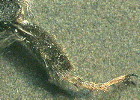 Examining the three pairs of legs
will reveal the detail of the claws, hairs, spines and structure
of the jointed limbs. The legs play an important role in bees
during pollen collection.
Examining the three pairs of legs
will reveal the detail of the claws, hairs, spines and structure
of the jointed limbs. The legs play an important role in bees
during pollen collection.
If you are interested in carrying out a proper dissection of a bee (or other insect) particularly with a view to preparing a set of insect parts as permanent microscope slides, an excellent series of booklets are published by Northern Biological Supplies (UK) (follow Shop links). These are available as separate booklets (eg on bee, insect, or arthropod dissection) or as a bound set of booklets sold as 'Practical Microscopy'. All the materials and equipment required to prepare permanent slides are discussed.
Final thoughts:
So that's it folks, after a year of these Nature Walks I
hope I've managed to pass on some of my enthusiasm for the
wonderful close-up world of nature around us. Even if you never
buy a microscope, do treat yourself to a 10X hand-lens and carry
it when you're on a country walk or just wandering around the
garden. There's so much of interest to see at any time of the
year both on the macro- and microscopic scale.
Suggested reading
Capturing nature in close-up for the Web
- a special supplementary article showing the ways you can
capture images, and shows how the author produces this Walk
series.
Read an article 8X More, on choosing and using a hand lens, and even find out how you can take video pictures through it.
Northern Biological Supplies (UK), produce excellent booklets on insect disection and preparing permanent mounts on microscope slides.
Most libraries will have books on Invertebrate Zoology which cover insect structure in detail.
Image details
Camera images were transferred to the PC using a Creative Video
Spigot capture card.
Image manipulation using Photostyler v2.0 software.
Return to Micscape Magazine Front Page
The author Dave Walker
is a UK based amateur naturalist keen to encourage people to
explore nature in close-up.